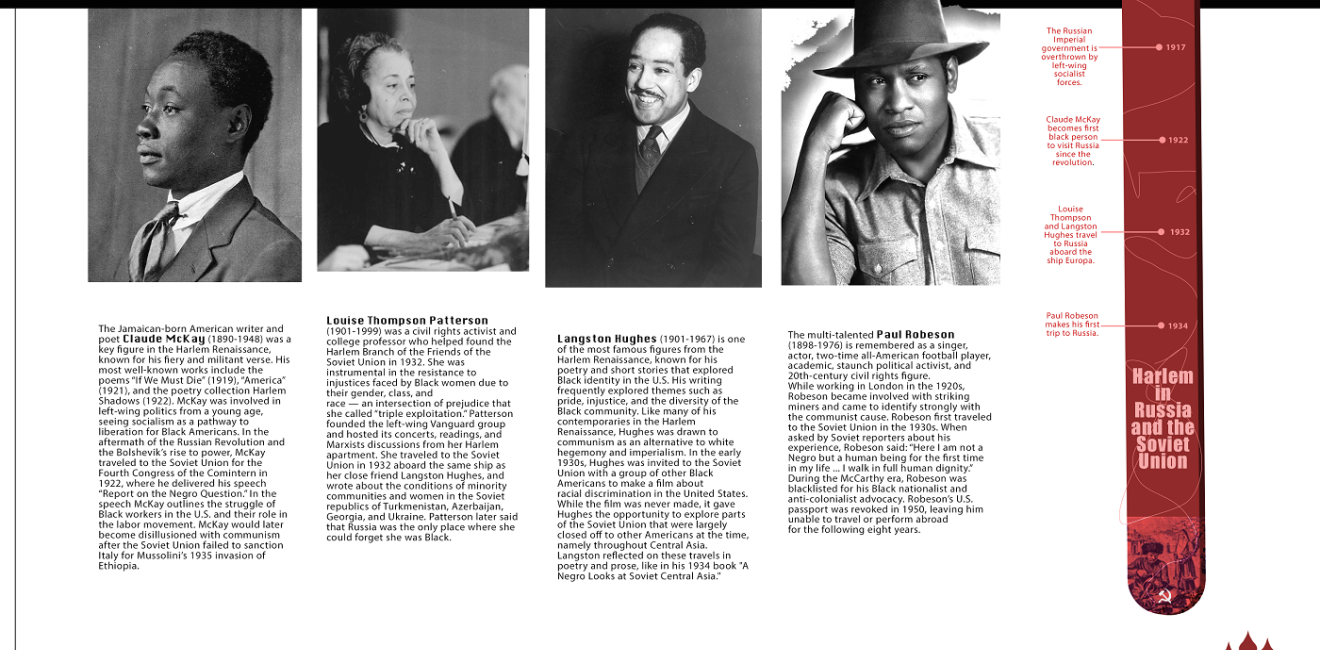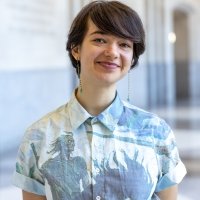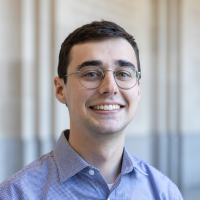Infographic | Harlem Renaissance in the Soviet Union
For Black History Month 2023, learn more about figures from the Harlem Renaissance and their experiences in the Soviet Union.
For Black History Month 2023, learn more about figures from the Harlem Renaissance and their experiences in the Soviet Union.

Some of the earliest Black Americans to travel to the Soviet Union belonged to the cultural movement known as the Harlem Renaissance. Many of these figures were drawn to the Soviet Union in the 1930s because they saw it as a “red Mecca” of equality, which stood in contrast to the racism they endured in the United States. The Soviet Union, in turn, welcomed the opportunity to highlight racial inequality in the United States and to demonstrate the multiculturalism of the Soviet republics. While the phenomenon of Black American artists visiting the Soviet Union slowed considerably at the onset of the Cold War, their travels to the USSR left an impression on both the artists and Soviet society.

The Jamaican-born American writer and poet Claude McKay (1890-1948) was a key figure in the Harlem Renaissance, known for his fiery and militant verse. His most well-known works include the poems “If We Must Die” (1919), “America” (1921), and the poetry collection Harlem Shadows (1922). McKay was involved in left-wing politics from a young age, seeing socialism as a pathway to liberation for Black Americans. In the aftermath of the Russian Revolution and the Bolshevik’s rise to power, McKay traveled to the Soviet Union for the Fourth Congress of the Comintern in 1922, where he delivered his speech “Report on the Negro Question.” In the speech McKay outlines the struggle of Black workers in the U.S. and their role in the labor movement. McKay would later become disillusioned with communism after the Soviet Union failed to sanction Italy for Mussolini’s 1935 invasion of Ethiopia.
Louise Thompson Patterson (1901-1999) was a civil rights activist and college professor who helped found the Harlem Branch of the Friends of the Soviet Union in 1932. She was instrumental in the resistance to injustices faced by Black women due to their gender, class, and race — an intersection of prejudice that she called “triple exploitation.” Patterson founded the left-wing Vanguard group and hosted its concerts, readings, and Marxists discussions from her Harlem apartment. She traveled to the Soviet Union in 1932 aboard the same ship as her close friend Langston Hughes, and wrote about the conditions of minority communities and women in the Soviet republics of Turkmenistan, Azerbaijan, Georgia, and Ukraine. Patterson later said that Russia was the only place where she could forget she was Black.
Langston Hughes (1901-1967) is one of the most famous figures from the Harlem Renaissance, known for his poetry and short stories that explored Black identity in the U.S. His writing frequently explored themes such as pride, injustice, and the diversity of the Black community. Like many of his contemporaries in the Harlem Renaissance, Hughes was drawn to communism as an alternative to white hegemony and imperialism. In the early 1930s, Hughes was invited to the Soviet Union with a group of other Black Americans to make a film about racial discrimination in the United States. While the film was never made, it gave Hughes the opportunity to explore parts of the Soviet Union that were largely closed off to other Americans at the time, namely throughout Central Asia. Langston reflected on these travels in poetry and prose, like in his 1934 book "A Negro Looks at Soviet Central Asia."
The multi-talented Paul Robeson (1898-1976) is remembered as a singer, actor, two-time all-American football player, academic, staunch political activist, and 20th-century civil rights figure. While working in London in the 1920s, Robeson became involved with striking miners and came to identify strongly with the communist cause. Robeson first traveled to the Soviet Union in the 1930s. When asked by Soviet reporters about his experience, Robeson said: “Here I am not a Negro but a human being for the first time in my life ... I walk in full human dignity.” During the McCarthy era, Robeson was blacklisted for his Black nationalist and anti-colonialist advocacy. Robeson’s U.S. passport was revoked in 1950, leaving him unable to travel or perform abroad for the following eight years.
Photo Credits
Claude McKay Internet Archive / Wikimedia Commons
Louise Thompson Patterson German Federal Archive / Wikimedia Commons
Langston Hughes Library of Congress / Wikimedia Commons
Paul Robeson Wikimedia Commons



The Kennan Institute is the premier US center for advanced research on Eurasia and the oldest and largest regional program at the Woodrow Wilson International Center for Scholars. The Kennan Institute is committed to improving American understanding of Russia, Ukraine, Central Asia, the South Caucasus, and the surrounding region through research and exchange. Read more
